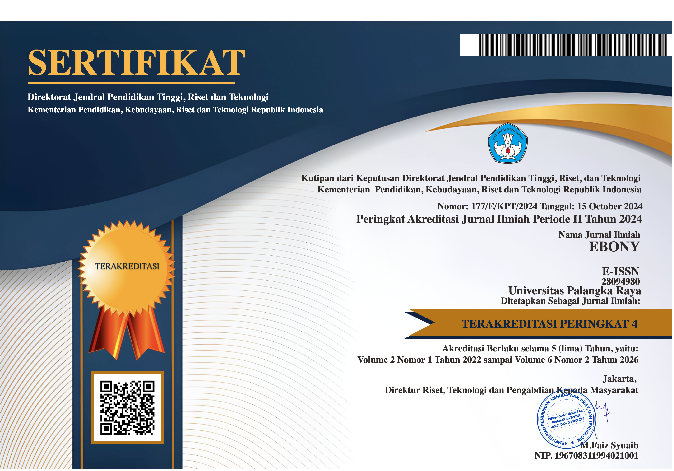Model Minority Reconstruction in ONE OK ROCK’s “Stand Out Fit In”
DOI:
https://doi.org/10.37304/ebony.v5i2.22081Keywords:
model minority, discourse analysis, biculturalismAbstract
The study explores the model minority myth represented in one of ONE OK ROCK’s songs “Stand Out Fit In” written in English. The concept of model minority attributes the image of Asian American as hard workers in terms of academic and economic achievement in a White society, but it neglects the psychological well-being due to the pressure from Asian American parental expectation and the racism faced by Asian American adolescents. Therefore, the study aims to reconstruct the model minority concept through the analysis of song lyrics and music video scenes of “Stand Out Fit In” by using a discourse analysis framework focusing on the narrative techniques. The result shows that the activity scheme including the repetition of ‘stand out fit in’ in the lyrics and the Bian Lian dance performance in several scenes suggest the new model of model minority proposing the biculturalism concept which is not only maintaining the image of Asian American as high achievers, but also ‘fit[ting] in’ the mainstream society to challenge racism and bias perception of Asian American. This new concept of model minority indicates the cultural adoption strategy, which may lead to Asian Americans' position as ‘honorary white’ in the White supremacy.
Downloads
References
Anjana, R. P. D., & Husnul, R. (2023). Javanese-Bashu Cultural Art Adaptation. Journal of Maobi, 1(1), 20. https://doi.org/10.20961/maobi.v1i1.79727
Ayton, D., Tsindos, T., & Berkovic, D. (2023). Qualitative Research – a practical guide for health and social care researchers and practitioners. Monash University.
Bedford, O., & Yeh, K.-H. (2021). Evolution of the Conceptualization of Filial Piety in the Global Context: From Skin to Skeleton. Frontiers in Psychology, 12. https://doi.org/10.3389/fpsyg.2021.570547
Benet‐Martínez, V., & Haritatos, J. (2005). Bicultural Identity Integration (BII): Components and Psychosocial Antecedents. Journal of Personality, 73(4), 1015–1050. https://doi.org/10.1111/j.1467-6494.2005.00337.x
Berry, J. W. (2006). Contexts of Acculturation. In D. L. Sam & J. W. Berry (Eds.), The Cambridge Handbook of Acculturation Psychology (1st ed., pp. 27–42). Cambridge University Press.
Chen, G. A., & Buell, J. Y. (2018). Of models and myths: Asian(Americans) in STEM and the neoliberal racial project. Race Ethnicity and Education, 21(5), 607–625. https://doi.org/10.1080/13613324.2017.1377170
Chen, X., & Padilla, A. M. (2019). Role of Bilingualism and Biculturalism as Assets in Positive Psychology: Conceptual Dynamic GEAR Model. Frontiers in Psychology, 10. https://doi.org/10.3389/fpsyg.2019.02122
Cheung, C. W., & Swank, J. M. (2019). Asian American Identity Development: A Bicultural Model for Youth. Journal of Child and Adolescent Counseling, 5(1), 89–101. https://doi.org/10.1080/23727810.2018.1556985
Dhingra, P. (2021). “Over-zealous Parents, Over-programmed Families”: Asian Americans, Academic Achievement, and White Supremacy. Sociology of Race and Ethnicity, 7(4), 458–471. https://doi.org/10.1177/23326492211018483
Drompp, M. R. (2011). The Lone Wolf in Inner Asia. Journal of the American Oriental Society, 131(4), 515–526.
Fan, X. (2019). The Research and Application of Critical Discourse Analysis. Journal of Language Teaching and Research, 10(5), 1041–1046.
Graham, P. (2018). Ethics in critical discourse analysis. Critical Discourse Studies, 15(2), 186–203. https://doi.org/10.1080/17405904.2017.1421243
Huynh, Q.-L., Benet-Martínez, V., & Nguyen, A.-M. D. (2018). Measuring variations in bicultural identity across U.S. ethnic and generational groups: Development and validation of the Bicultural Identity Integration Scale—Version 2 (BIIS-2). Psychological Assessment, 30(12), 1581–1596. https://doi.org/10.1037/pas0000606
Hyunseo, L. (2021, September 3). Music as a cultural remedy: Exploring the role of music as a way for Asian-American youth to navigate their dual identity in the socio-political context following the COVID-19 outbreak. Proceedings of The 3rd World Conference on Social Sciences. https://doi.org/10.33422/3rd.worldcss.2021.09.20
Kim Lee, S. (2020). Asian Americanist Critique and Listening Practices of Contemporary Popular Music. In Oxford Research Encyclopedia of Literature. Oxford University Press. https://doi.org/10.1093/acrefore/9780190201098.013.819
Kobayashi, K., Jackson, S. J., & Sam, M. P. (2019). Globalization, creative alliance and self-Orientalism: Negotiating Japanese identity within Asics global advertising production. International Journal of Cultural Studies, 22(1), 157–174. https://doi.org/10.1177/1367877917733812
Labov, W. (2006). Narrative pre-construction. Narrative Inquiry, 16(1), 37–45. https://doi.org/10.1075/ni.16.1.07lab
Lim, W. M. (2025). What Is Qualitative Research? An Overview and Guidelines. Australasian Marketing Journal, 33(2), 199–229. https://doi.org/10.1177/14413582241264619
Lo, R. F., Padgett, J. K., Cila, J., Sasaki, J. Y., & Lalonde, R. N. (2022). The reemergence of Yellow Peril: Beliefs in the Asian health hazard stereotype predict lower psychological well-being. Asian American Journal of Psychology, 13(4), 339–350. https://doi.org/10.1037/aap0000291
Machin, D. (2010). Analyzing Popular Music: Image, Sound, Text. SAGE Publications Ltd.
Mogashoa, T. (2014). Understanding Critical Discourse Analysis in Qualitative Research. International Journal of Humanities Social Sciences and Education, 1(7), 104–113.
Moody, A. J. (2006). English in Japanese popular culture and J-Pop music. World Englishes, 25(2), 209–222. https://doi.org/10.1111/j.0083-2919.2006.00460.x
Mullet, D. R. (2018). A General Critical Discourse Analysis Framework for Educational Research. Journal of Advanced Academics, 29(2), 116–142. https://doi.org/10.1177/1932202X18758260
Oliva, R., Bidarra, J., & Araújo, D. (2017). Video and storytelling in a digital world: interactions and narratives in videoclips. Comunicação e Sociedade, 32, 459–476. https://doi.org/10.17231/comsoc.32(2017).2772
Osborn, B. (2021). Interpreting Music Video Popular Music in the Post-MTV Era. Routledge.
Park, J. S. (2015). Searching for a Cultural Home: Asian American Youth in the EDM Festival Scene. Journal of Electronic Dance Music Culture, 7(1), 15–34.
Rouse, W. L. (2019). Between Two Worlds: Chinese Immigrant Children and the Production of Knowledge in the Era of Chinese Exclusion. KNOW: A Journal on the Formation of Knowledge, 3(2), 263–282. https://doi.org/10.1086/704718
Schmidt, C., Cho, H. S., & Cheah, C. S. L. (2023). To Be in Harmony: Chinese American Adolescents’ and Parents’ Bicultural Integration During the COVID-19 Pandemic. Journal of Cross-Cultural Psychology, 54(4), 475–489. https://doi.org/10.1177/00220221231171062
Schwartz, S. J., & Unger, J. B. (2010). Biculturalism and Context: What Is Biculturalism, and When Is It Adaptive? Human Development, 53(1), 26–32. https://doi.org/10.1159/000268137
Shih, K. Y., Chang, T., & Chen, S. (2019). Impacts of the Model Minority Myth on Asian American Individuals and Families: Social Justice and Critical Race Feminist Perspectives. Journal of Family Theory & Review, 11(3), 412–428. https://doi.org/10.1111/jftr.12342
Thompson, A. I. (2023). Asian American Racial Threat and Support for Racially Discriminatory Policy. Political Science Research and Methods, 1–18. https://doi.org/10.1017/psrm.2023.24
Vietze, J., Juang, L. P., & Schachner, M. K. (2019). Peer cultural socialisation: a resource for minority students’ cultural identity, life satisfaction, and school values. Intercultural Education, 30(5), 579–598. https://doi.org/10.1080/14675986.2019.1586213
Wodak, R. (2022). Critical Linguistics and Critical Discourse Analysis. In J. Verschueren & J.-O. Ostman (Eds.), Handbook of Pragmatics (2nd ed., pp. 423–443). John Benjamins.
Wong, D. (2019). Drumming Through Princess of China: Intercultural Encounters in a Hollywood Music Video. El Oído Pensante, 7(1), 74–99.
Yang, J., & Zhao, X. (2021). Does all work and no play make elite students? Evidence from the China education panel survey. International Journal of Educational Development, 80, 102321. https://doi.org/10.1016/j.ijedudev.2020.102321
Yip, T., Cheah, C. S. L., Kiang, L., & Hall, G. C. N. (2021). Rendered invisible: Are Asian Americans a model or a marginalized minority? American Psychologist, 76(4), 575–581. https://doi.org/10.1037/amp0000857
Yu-qi, W. (2024). Analysis on Bicultural Identities of Chinese Americans Based on Acculturation Theory. Sino-US English Teaching, 21(6), 280–285.
Downloads
Published
How to Cite
Issue
Section
License
Copyright (c) 2025 Maria Niayu Risma Novianti

This work is licensed under a Creative Commons Attribution 4.0 International License.











